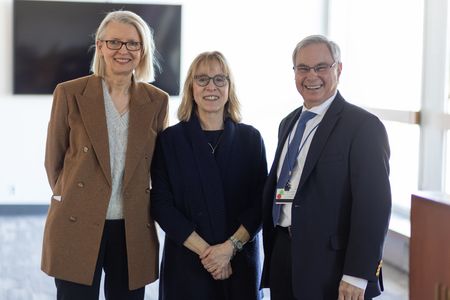Science Day 2025 Makes History with Highest-Ever Participation Rate
At the 2025 GSDM Science Day on February 14, a record-breaking 55 students, residents, and fellows presented their cutting-edge experimentations, showcasing the school’s latest contributions to advancing the field’s knowledge.
Science Day allows all participants the opportunity to highlight their key research takeaways to the Boston University Medical Campus (BUMC) community, either delivering poster presentations in person or oral presentations shared via Zoom.
“This year, we have more projects and more presenters than we’ve ever had before,” said Kendrick Smaellie, assistant director of predoctoral research and program manager at GSDM’s Center for Clinical Research. “This demonstrates that our students and residents continue to be interested in and committed to research as part of their dental education and training.”

Eighteen DMD and DMD Advanced Standing students, 25 master’s students, and 12 postdoctoral residents presented 50 unique projects.
“Science Day provides an opportunity for our school to reveal publicly the diverse research being conducted by our community,” said Dean Cataldo Leone. “I continue to be impressed by the depth and breadth of the work done, not only by our residents and students, but also by their dedicated and outstanding mentors.”
The event’s keynote speech was delivered by Dr. Vicki Rosen, professor and chair of the Department of Developmental Biology at Harvard School of Dental Medicine. Rosen also holds the Doctors Samuel and Ida Gelfand Professorship, an endowed position recognizing scholars in emerging areas of scientific inquiry.

In her presentation “Physiological Regulation of BMP Signaling in the Skeleton,” Rosen said the skeleton is built from the sum of independent domains of BMP (Bone Morphogenetic Protein) expression with signaling driving the size and shape of skeletal elements.
The periosteum is a skeleton stem cell niche that regulates bone width that is tied to BMP activity. Injuries to periosteum are a common occurrence with 12 to 15 million fractures annually in the U.S. with 5-10% of the fractures failing to heal successfully. By understanding the relationship between distinct skeletal stem cell populations, Rosen said clinicians may be able to find more effective ways to treat skeletal diseases.
“We think understanding this relationship between stem cell populations and their niche will allow more stem cell-based therapies that are effective, not just BMP2,” Rosen said. “And perhaps we can actually engineer an optimal niche as a way to treat skeletal diseases, so you don’t have to wait until we have a fracture that we have to fix or lack of regeneration.”
After presenting “Analysis of the Remineralized Crystal Morphology and Mechanical Properties at Interface Between Natural Enamel and Composite Resin-An Ex-Vivo Study,” Harshal Modh PROS 28 expressed a great enthusiasm for Science Day and a desire to pursue further enamel research.
“I really like Science Day because you get to meet all the other faculties, all different residents, all other dental students, and you get to know what is happening in Boston University,” Modh said
Janvi Mody PERIO 23 28 said participating in Science Day with her presentation “Coffee Extracts Mitigate Osteoclast Activity in the Presence of LPS-Induced Bone Damage” was her first time working on scientific research of this caliber. She is looking forward to taking the skills she learned during this experiment and applying them to future research opportunities.
“BU was my first research experience, so that was great to learn so many new techniques,” Mody said.
